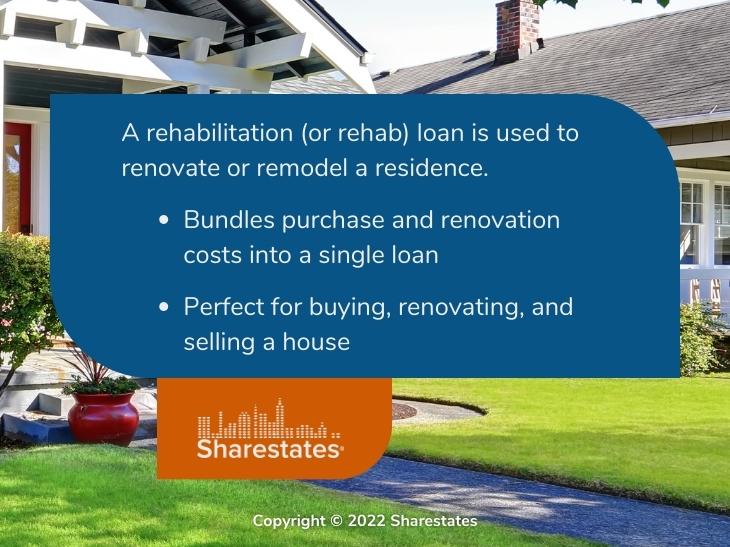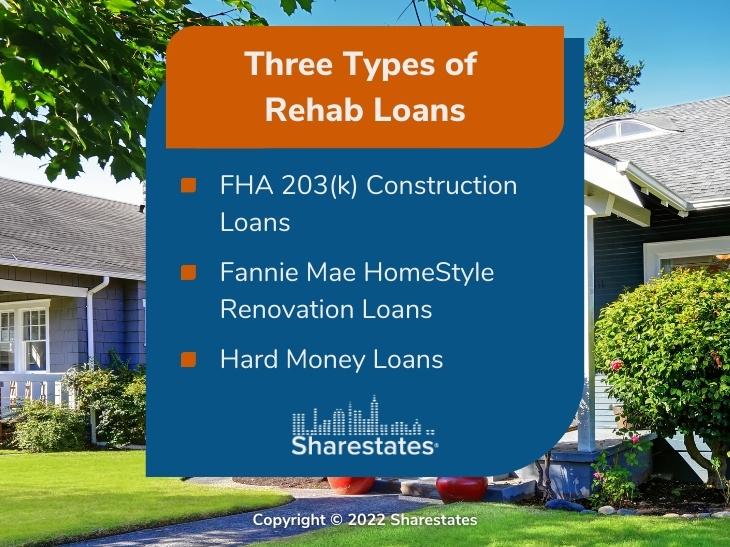In this article, we discuss the three main types of rehabilitation loans (rehab loans) and how they can be used to finance an investment property.
What Is a Rehab or Rehabilitation Loan?
A rehabilitation loan or rehab loan is used to renovate or remodel a residence. The rehab loan bundles both the purchase and renovation costs into a single loan. They are perfect for buying a house, renovating it, and selling it.
Three Types of Rehab Loans
There are three main types of rehab loans: FHA 203(k) construction loans, Fannie Mae HomeStyle loans, and Hard Money loans. Here are the key types and an overview of their advantages and disadvantages.

FHA 203(k) Construction Loans
These are federal government loans, also known as 203(k) loans. They have the same requirements as all FHA loans. The borrower will need to meet credit rating and debt-to-income ratio requirements. The loan is based on the home’s value after improvements or the after-repair-value (ARV). These loans offer low down payments, as low as 3.5%, require mortgage insurance, can be fixed or adjustable rate, and have a deadline of six months to complete the rehabilitation. Note that first-time investors can only use this loan, and the owner must occupy it for at least 12 months.
Fannie Mae HomeStyle Renovation Loans
This is also a federal government loan. Down payments are higher at around 5%, borrowing is limited to 85% of the after-repair-value, and the renovations must be completed in 12 months. One challenge is that a licensed, insured contractor must conduct renovations. Plus, the lender must review all plans and conduct regular inspections of the work. That makes it tough to line up a lender and contractor willing to go through this time-consuming and costly process.
The FHA 203(k) and the Fannie Mae HomeStyle loans come with extensive government assistance. That takes the form of a rigorous and lengthy application process and short construction timeframes. In the case of the HomeStyle loan, restrictions on who can do the renovations and detailed progress inspections. That’s not the case with hard money loans.
Hard Money Loans
Hard money loans are issued by private lenders instead of banks or credit unions. This means they can take on more risk than traditional lenders in exchange for a higher interest rate and fees. Private lenders will underwrite loans for borrowers that often have no other financing options. This is because the loans are secured by the underlying property value rather than by the borrower’s credit record.
Due to the higher risk, interest rates for hard money loans run between 7% and 15%. Closing fees can go as high as 5 or 6 points. The loan-to-value (LTV) ratio is usually lower than 80% of the property value. However, some lenders will base the loan on the after-repair value (ARV). Loan terms can extend up to three years but are often 12 months or less. One significant advantage of hard money loans is that the application process can be completed in just a few days. For further insight, see our article Hard Money Loans: Everything You Need to Know.
Rehab Loan Options
That’s a quick overview of the three major types of rehabilitation loans. As you can tell, there are advantages and disadvantages between these loan options. Hard money loans can be secured quickly but bring additional costs due to higher interest rates and closing points. The FHA and Fannie Mae loans carry lower costs but much shorter terms, a great deal of paperwork, and considerable oversight during the loan term.
We hope this review has helped provide insight into rehab loans. To learn more about getting funding for your business through Sharestates, click here.



